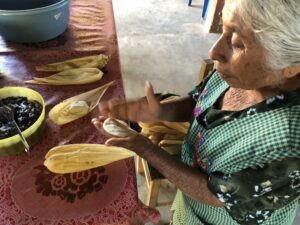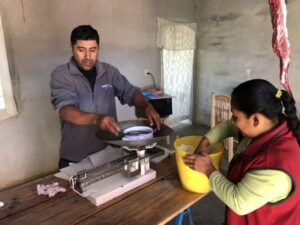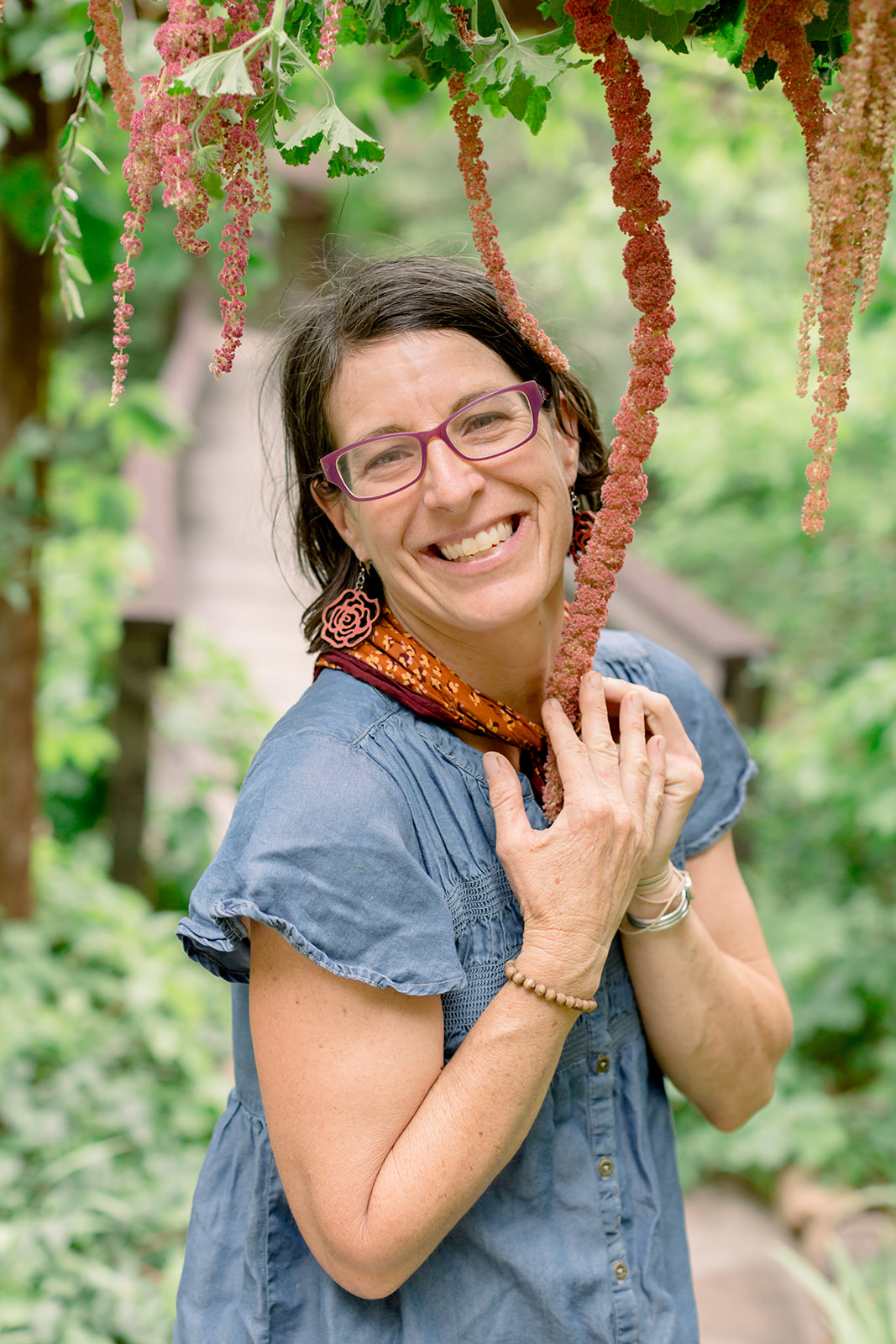 When you receive an invitation from an abuelita at a Mexican market to help her make tamales, the answer is always: YES. My July FlagLive column (link) begins with corn seeds in Oaxaca Mexico, and now Chelsea (my farm friend and traveling companion) and I find ourselves in a small village an hour outside of Oaxaca City. From the moment we met Marita and tasted her homemade tamales, we were smitten by both. The tamale is a labor of love, even if you start with a bag of corn masa from the supermarket. Add the growing and processing of the corn for this steamed treasure of dough and filling wrapped in corn husks, and it becomes an act of love. Love of corn; a seed that holds a legacy of human ingenuity.
When you receive an invitation from an abuelita at a Mexican market to help her make tamales, the answer is always: YES. My July FlagLive column (link) begins with corn seeds in Oaxaca Mexico, and now Chelsea (my farm friend and traveling companion) and I find ourselves in a small village an hour outside of Oaxaca City. From the moment we met Marita and tasted her homemade tamales, we were smitten by both. The tamale is a labor of love, even if you start with a bag of corn masa from the supermarket. Add the growing and processing of the corn for this steamed treasure of dough and filling wrapped in corn husks, and it becomes an act of love. Love of corn; a seed that holds a legacy of human ingenuity.
That morning we met Marita’s daughter, Juanita, at the village square. She was carrying a colorful plastic pail you might take to the beach to build sandcastles, but it was full of plump, freshly nixtamalized corn kernels. Nixtamalization is an ancient process to remove the hull of the corn seed by boiling and soaking corn in an alkaline solution. Not only does this make the corn easier to grind, it also increases the flavor and aroma and reduces the risk of disease from fungi that colonize grain crops. Now the bucket of soft, swollen corn kernels are ready to grind into masa. This is a service available in most Mexican villages at the local tortillaria. We leave with our corn transformed to freshly ground corn masa.
 At our next stop the butcher adds freshly rendered fat directly into the pail, an essential binding ingredient for the corn masa.
At our next stop the butcher adds freshly rendered fat directly into the pail, an essential binding ingredient for the corn masa.
Finally, we make our way to Marita’s kitchen where the real work will ensue. This kitchen is designed for use with a concrete floor, refrigerators of varying sizes, and a big table in the center covered with a colorful plastic tablecloth. A low wall of adobe bricks connects it to the backyard—another hub of activity—and woven grass thatch walls provide shade and airflow. Jesus beckons with a sacred heart and open arms on a calendar decoupaged with grains and plants. Before we begin, Marita serves us the chicken mole and black bean filling to sample in an enamel metal bowl decorated with painted flowers with a fresh tortilla to cradle it all. I love that we begin with nourishment, as we have a long day ahead of us.
There are no measuring cups or kitchen aids. They mix by muscle memory and with fluidity, as this is a weekly routine to feed their family and neighbors. Juanita shows us how to roll the masa on a tool unique to Mexico—something like a tortilla press shaped like an ironing board. Then she ladles the two types of fillings; mole—itself another day of preparation with grinding and fusing of countless nuts, seeds, chilies, spices with chicken—and black beans expertly soaked, simmered and spiced. Lastly, an Hoja Santa leaf (translated holy leaf) with flavors of anise, eucalyptus and mint, is delicately laid on top. The sides of the corn masa are folded three ways and then wrapped in the corn husks, which were also obtained from the same cobs that yielded the corn.
The steps are demonstrated by Marita while she murmurs in a low, almost animal-like growl interspersed with fits of laughter as we attempt to decipher the details in our elementary Spanish. Then we attempt the same motions with klutzy movements, while Marita demonstrates the simple method of pressing the masa into the corn husk by hand with her fingertips.
At last we have a towering pot layered with tamales ready to steam. The fire pit has been primed and the coals are hot. Marita places a thorny branch on the lid she explains helps keep the crows away. Juanita shoos us away from cleanup duties as her mom beckons to us to sit down next to her to chat as they steam. Chelsea is no stranger to feeding people and looks at home in her apron. I remember the wood-fired pizzas she made for 40 apprentices on the U.C. Santa Cruz Farm with the homemade dough from various local grains she was testing. Both of us love to cook and eat, especially food we have grown. There is something magical that is infused when you begin with a seed and it ends up on your table, feeding friends and family. It is the ultimate gift.
After about an hour of swapping stories of the plants we grow and recipes, the tamales were ready. The finishing touch was to let them rest in a big plastic bowl beneath one of Marita’s hand-embroidered flower towels. Now for the long anticipated moment; peeling back the soft, hot husks to taste love, earth, and literally seeds that made this nurturing and delicious comfort food. Juanita pours us all a short glass of mescal and we toast to the tamale and each other.
I returned from Oaxaca with seeds and ideas and one of Marita’s special towels. The trip had literally been a feast of delicious food that filled my belly and ignited a my hunger to grow real food and feed people.
At our farm in Rimrock under the harvest moon, the cicada orchestra reaches deafening crescendos as we sit down to eat a stack of homemade corn tortillas wrapped in Marita’s colorful towel, with our neighbors, Belle and Bille. Bill, a passionate seed saver and educator, gave us his extra corn seedlings and we planted them along with the Oaxacan seeds this spring. After a summer of desert heat and sufficient monsoons, the field is glorious sight. Bill is beaming at the success of our collective corn patch, as the Cornville seeds he gave us, now four seasons selected and saved, are by far the most vigorous. The plants tower over us as we peel back the sheaths to find a variety of colors—burgundy, a deep blue black, a small pink, a creamy yellow and occasional blue kernels revealing the genes of generations of farmers and seed savers.
As I marvel at the beautiful varieties of corn growing at our Rimrock farm, I realize that no matter where these seeds physically came from, what’s most important is that they come from the hearts of those committed to protecting the food and traditions of the cultures of our living Earth. I’m honored to be a part of a community, near and far, of farmers, food lovers and seed savers on collective mission to love people and feed them.


